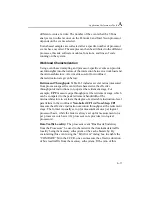
IA-32 Intel® Architecture Optimization
B-2
The performance metrics listed n Tables B-1 through Table B-5 may be
applicable to processors that support Hyper-Threading Technology, see
Using Performance Metrics with Hyper-Threading Technology section.
Pentium 4 Processor-Specific Terminology
Bogus, Non-bogus, Retire
Branch mispredictions incur a large penalty on microprocessors with
deep pipelines. In general, the direction of branches can be predicted
with a high degree of accuracy by the front end of the Intel Pentium 4
processor, such that most computations can be performed along the
predicted path while waiting for the resolution of the branch.
In the event of a misprediction, instructions and micro-ops (
μ
ops) that
were scheduled to execute along the mispredicted path must be
cancelled. These instructions and
μ
ops are referred to as
bogus
instructions and
bogus
μ
ops. A number of Pentium 4 processor
performance monitoring events, for example,
instruction_ retired
and
mops_retired
, can count instructions or
μ
ops that are retired based
on the characterization of bogus versus non-bogus.
In the event descriptions in Table B-1, the term “bogus” refers to
instructions or micro-ops that must be cancelled because they are on a
path taken from a mispredicted branch. The terms “retired” and
“non-bogus”
refer to instructions or micro-ops along the path that
results in committed architectural state changes as required by the
program execution. Thus instructions and
μ
ops are either bogus or
non-bogus, but not both.
Bus Ratio
Bus Ratio is the ratio of the processor clock to the bus clock. In the Bus
Utilization metric, it is the Bus_ratio.
Summary of Contents for ARCHITECTURE IA-32
Page 1: ...IA 32 Intel Architecture Optimization Reference Manual Order Number 248966 013US April 2006...
Page 220: ...IA 32 Intel Architecture Optimization 3 40...
Page 434: ...IA 32 Intel Architecture Optimization 9 20...
Page 514: ...IA 32 Intel Architecture Optimization B 60...
Page 536: ...IA 32 Intel Architecture Optimization C 22...
















































